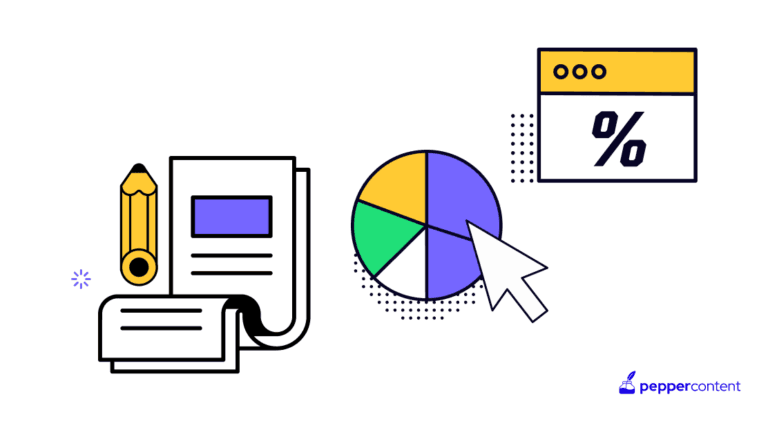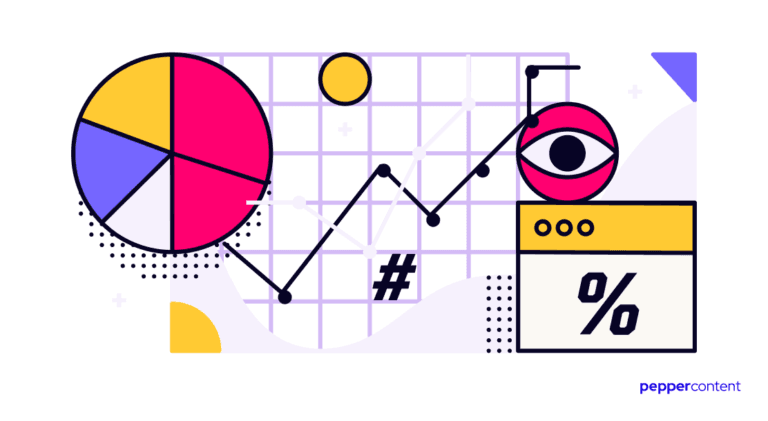Your Expert Guide to Content Marketing Analytics

The year 2020 has proved to be somewhat of an inflection point for the content marketing industry. The reason: the pandemic, of course.
Brands had to rethink their content marketing strategies to align with the new normal and changing consumer habits. For instance, food delivery brands like Swiggy and Zomato had to rejig their content marketing campaigns and messaging to focus on contactless delivery and adherence to COVID-19 safety protocols.
The extended periods of lockdown have also forced brands to go digital and embrace content marketing over traditional ATL (above-the-line) marketing channels. This has led to an explosion of content on popular digital platforms like Facebook, Instagram, and Google. According to The Brandon Agency, the number of internet users (in the UK and the US) sharing more content than ever before on social media has surged by 55% during the pandemic.
More and more brands are jostling for users’ limited attention on the same inventory (feed, stories, search), culminating in banner blindness and advertising fatigue. The digital space has become a hotly contested battleground where brands are vying to capture the maximum user mindshare with witty, quirky, and engaging content. A Semrush survey found that 84% of brands have proper content marketing strategies in their business arsenal.
The Way Forward
In this backdrop, brands need to be smart about how they approach content marketing. A spray-and-pray approach will not work and will only lead to the sad demise of marketing dollars. Brands need to measure the success of their content marketing efforts by tracking some key metrics. Earlier, these used to be likes, upvotes, shares, page views, and so on. But do these metrics really capture the effectiveness of your tactics? Do they really tell the real story of whether the content you push out is striking a chord with your target audiences? Can you say, with a reasonable degree of certainty, it is converting visitors to prospects and prospects to customers?
The answer is no. For that, we need content marketing analytics.
The Need for Content Marketing Analytics
Whether you can draw a direct line between your content marketing and revenue earning is the Holy Grail. Can you track a visitor’s journey from your blog to your bank account step by step? Do they subscribe to your newsletter after reading one of your articles? Do they sign up for a free trial? Do they upgrade to a premium plan? Do they stay around long enough to consider upgrading? These are important questions that cannot be answered by merely looking at dinosaur metrics like unique visitors, time on page, site views, etc.
Looking at these superficial metrics will only give you a myopic view of content performance. Stop giving undue importance to these vanity metrics. As Lori Taylor, founder of Rev Media Marketing, puts it, “Going viral is not an outcome; it’s a happening. Sometimes it happens; sometimes it doesn’t. Just remember, fans are vanity, and sales are sanity.”
If the content is king and distribution queen, then content marketing analytics is surely the throne – the foundation on which you build your marketing empire.
You need to drill down beyond the basic top-level metrics and really try to understand what makes your content tick. Is it an offer? Is it a particular benefit? A giant point of pain that your product solves?
Your content analysis needs to be granular so that you can pinpoint the exact message that is resonating with your audience. A nifty way to do that is reiterate or highlight catchy messages and add a ‘Click to Tweet’ button on them.
If people are clicking the button, it means that the content is clicking with them. This is one way you can overcome the challenge of proving content marketing effectiveness and demonstrate a clear ROI (return on investment).
How to Assign Content Marketing KPIs
Key Performance Indicators (KPIs) are important in any industry, let alone content marketing. They are the barometer for measuring the output of your content marketing efforts. This is why setting the right content marketing KPIs is crucial so that your whole organization can align with and calibrate business goals around them. A failure to do so can result in the following irritants:
- KPIs gather dust as no one uses them because they find them irrelevant.
- There is a lack of clarity regarding how to measure those subjective, intangible goals like customer satisfaction.
- No coherence between your content marketing strategy and KPIs can lead to suboptimal use of funds and efforts.
Here are some tips on maintaining the right yardsticks and assigning appropriate content marketing KPIs to avoid this disaster.
1. Understand what a KPI is (and what it really isn’t)
To set the right KPIs, we first need to understand what they don’t involve. Too many brands make the folly of defining the following as content marketing KPIs:
- Positive user feedback surveys
- Getting 1000 blog subscribers in a month
- Content virality
The first is just a data collection exercise, while the second is more like a milestone, a checkpoint (a lagging metric, a sign of progress, but not performance). The third is a vague, loosely defined term that could be interpreted in multiple ways. KPIs should be the leading metric.
KPIs are quantifiable, unambiguous indicators that provide conclusive and irrefutable evidence of performance. For example, if you want to measure shareability, Google Analytics can give you a unified view of all the channels where your content is being shared.
2. Evaluate existing KPIs
Run a thorough audit of your current KPIs to understand which ones are still applicable and which ones have become outdated. For example, LTV (Lifetime Value) might not be a relevant KPI if you’ve transitioned to a free, ad-supported business model. Use this framework to separate the must-haves from the ones that can be discarded.
Also, be careful not to have too many KPIs.
3. Ensure that your goals are measurable
Too often, we lazily create business goals around KPIs instead of the other way round. Our starting point is, “What can we measure?” when it should be, “Is this goal measurable?” Meaningful performance analysis requires careful wording of goals so that they are specific and measurable. Check if your current goals are quantifiable and go through this tutorial for writing measurable goals.
4. All hands on deck
Assigning the right content marketing KPIs is impossible without getting all the key stakeholders involved – the people who understand users, the market, the product, and the data. Outsourcing it to consultants is fraught with risks as they have too little skin in the game and very limited visibility to make an informed decision. Create a draft KPI master document so that everyone can see and comment on it and clearly outline your rationale behind every KPI – be it CPA (cost per acquisition), CPL (cost per lead), churn rate, or something else.

Jay Baer’s guide to content marketing metrics
To sum up the story so far, blindly pushing out content is about as useful as rowing a kayak with your hands. You need to obsessively monitor the performance measures that matter to your business and continuously optimize them. Iterate on the feedback you get and cull out the content that’s not getting any traction.
Renowned marketing consultant and social media customer service expert Jay Baer formulated a 4-pronged field guide to understanding and mastering content marketing analytics.
According to Baer, content marketing metrics can be bucketed under four broad categories. Without further ado, let’s dive in to analyze each type:
1. Consumption metrics
As a content marketer, you’re also a low-key publisher. And all publishers care about how their published content is received or consumed. More specifically, they seek answers to the following questions:
- How many people are going through my content?
- What channels are they using to discover and consume my content?
- What are their consumption traits, preferences, and likes/dislikes?
Consumption metrics help you to measure your website/app traffic and your brand awareness. Some of the commonly used metrics in this category include:
- Pageviews – Easy to set up and track using Google Analytics or a similar web analytics software.
- Video views – YouTube, Instagram, Tiktok, Twitch, all provide great analytics in this regard.
- Streams – For Spotify/Audible, this is the relevant metric that tells you how many times a piece of content was listened to.
- Downloads/installs – The App Store and the Play Store give comprehensive insights into how, where, and who is downloading your apps.
- Social chatter – Services like HootSuite and Tweetdeck are great for staying on top of brand mentions and measuring social chatter, in general.
2. Sharing metrics
Consumption metrics are important but not useful if kept siloed. Man is a social animal, and if we don’t share something after consuming it, it is an opportunity wasted. Sharing metrics measures your content’s social impact and its ability to spread on its own (like a virus, hence we use the term ‘viral content’ when something blows up). It is a self-sustaining mechanism whereby you can save a lot of $$$ by letting your fans do your work for you. Sharing is rooted in psychology, and brands are quickly getting up to speed on why people share:
- I want to come across as helpful so as to increase my social credibility.
- I want to showcase that I’m a part of an exclusive club (using something no one else is even aware of) to boost my social clout.
You can leverage these psychological insights to design highly shareable content. Some of the prominent metrics we use to measure a content’s shareability are:
- Likes, comments, shares, retweets, re-pins – The bread and butter of popular social media platforms like Facebook, Instagram, Twitter, and Pinterest.
- Email forwards – If you have a newsletter, the number of forwards dictates how much value your readers derive from it.
- Inbound links and embeds – The number of backlinks your content gets is a strong signal of your content authority and how well it thrives on the interwebs.
3. Lead-generation metrics
Next, we move a little further down the funnel and look at the metrics that influence the bottom line. One of the primary goals of content marketing (especially in B2B) is a lead generation and nurturing. Because ultimately, you want to convert leads into paying customers and paying customers into brand evangelists. A few lead-gen metrics that you should look at are:
- Blog subscribers – A healthy conversion rate at this step means your content is finding favor with your audience, and they can’t wait to have more of your content.
- Landing page signups – Often, a barebones landing page with crisp messaging and a clear articulation of benefits can work wonders. You can also create artificial scarcity by creating a waitlist to heighten the urgency.
- Form completions – A gated lead-gen form is perhaps the most challenging step to optimize for. Throw in a free ebook or some other goodies to incentivize visitors to part with their personal information.
- Conversion rate – This involves the fraction of visitors turning into leads.
4. Sales metrics
All roads lead to sales. Revenue and profitability are the ultimate North Star metric for content marketing. This is because business leaders essentially care about only one thing, “Did our business grow because of content marketing?” Obviously, you want to attract new customers through engaging content, but your existing customers can also play a crucial role in supercharging sales (by upselling or cross-selling). Some of the sales and customer acquisition metrics you can follow include:
- Online sales – This covers all the subscriptions, upfront buys, in-app purchases that your customers pay for throughout the period they interact with your product. It’s also known as LTV.
- Offline sales – You can assign a unique link or a QR code on products you sell through this channel and then cross-reference it with which piece of content led to the purchase of which product.
- Anecdotal sales – Not all revenue can be tracked automatically. You need to manually log all the handshake deals and in-person sales into your system.
Next, we look at how you can measure some of the important content marketing metrics.
Important metrics and how to track them
Now that we have a fair idea of the different kinds of metrics we need to track, let us try to understand how exactly we should go about tracking them:
1. Traffic
Most of the content marketing analytics start with discussions around ways and means to grow the influx of traffic, understand where it’s coming from, demographics, behavior, etc. Google Analytics provides a detailed breakdown regarding the various traffic sources, acquisitions, and user behavior. Head over to Behaviour > Overview for an in-depth understanding of the same.
2. CTR (click-through-rate)
CTR is one of the most important parameters which Rankbrain (Google’s page ranking algorithm) uses to display pages in the SERPs. As a content marketer, you need to relentlessly track and optimize this metric for all your pages to capture maximum SEO juice (average Adwords CTR is 1.9%, as per Wordstream). Write appealing meta descriptions to reel your visitors in and improve your CTR.
- Go to Google Search Console > Search Analytics.
- Check the Clicks, Impressions, and CTR boxes.
- Filter by Pages to get a page-wise view of the click-through performance of your website.
3) Backlinks
Backlinking is another SEO tactic that you can employ to get in Google’s good books. If several high-traffic sites point to your webpage, your domain authority and credibility shoot up, and you get a bump-up in the rankings. Here’s how you can find out who’s redirecting users to your web pages:
- Open Google Search Console.
- Navigate to Search Traffic.
- Click on ‘Links To Your Site’.
You will see a comprehensive dashboard of all your backlinks data in one place.
4) Time on page
This is another crucial metric that tells you how well you can keep your users hooked on your content. As a rule of thumb, most users spend around 15 seconds on a webpage, so if you find yourself below this mark, you need a content overhaul. To understand which pages are garnering the most attention and where users are just churning (Bounce Rate), fire up Google Analytics and go to Behaviors > Site Content > All Pages.
Most effective content marketing analytics tools (free and paid)
Last but not least, let us have a quick rundown of reliable content marketing analytics tools to augment our content marketing strategies:
1. Facebook Page Insights (FREE)
- Understand the reach and engagement levels of your posts (likes, comments, shares).
- Find out which posts triggered people to, unlike your page.
- Know when your followers are most active.
- Gain insight into the demographic and digital activity of your followers.
Check out this end-to-end Yoast guide for more details.
2. YouTube Analytics (FREE)
- Learn how many people clicked on the Play button.
- Know how many watched it till the last second, subscribed to your channel, commented, and shared it across their social networks.
- Find out the exact second when they got bored and dropped off.
- Get information about referral sources (suggested videos, social, Google, etc.).
3. Hotjar (PAID)
- View screen recordings of website visitors interacting with your website.
- Track the time they spend on a webpage or a blog.
- Find out how deep they scroll through heatmaps to identify absorbing and dull content.
4. SEMRush (PAID)
- Spy on your competitors’ SEO moves, keywords, backlinks, ad campaigns, and more.
- Monitor brand mentions, links, basically, whenever you get tagged in any online conversation.
- Understand if and how your content is moving the needle for you vis-a-vis keyword rankings.
5. Buzzsumo (PAID)
- Find influencers for every domain who can amplify the reach of your content.
- Enter your domain name to find your best-performing content in a given time period so that you can double down on it.
- Set keyword alerts to be in the loop whenever those keywords pop up online and monitor backlinks to your content.
Parting words
We hope this comprehensive guide gave you a 360-degree view of content marketing analytics and sheds light on the nitty-gritty of measuring content ROI. Remember the words of famous management guru Peter Drucker, “If you can’t measure it, you can’t improve it.”
Latest Blogs
Explore how Google’s 2025 AI search updates triggered ranking chaos. Learn actionable strategies to adapt your SEO for AI Overviews, zero-click searches, and SERP volatility. Stay ahead now.
Learn how to rank on AI search engines like ChatGPT, Perplexity, and Gemini by optimizing your content for authority, structure, and relevance. Stay ahead in AI-driven search with this strategic guide.
Explore the best healthcare SEO services for your medical practice. Improve online visibility and effectively reach more patients in need of your services.
Get your hands on the latest news!
Similar Posts

Content Analytics
8 mins read
Google I/O 2025: AI Search Shake-Up & Ranking Volatility

Content Analytics
5 mins read
How to Check Google Rankings: 3 Swift and Accurate Methods

Content Analytics
9 mins read